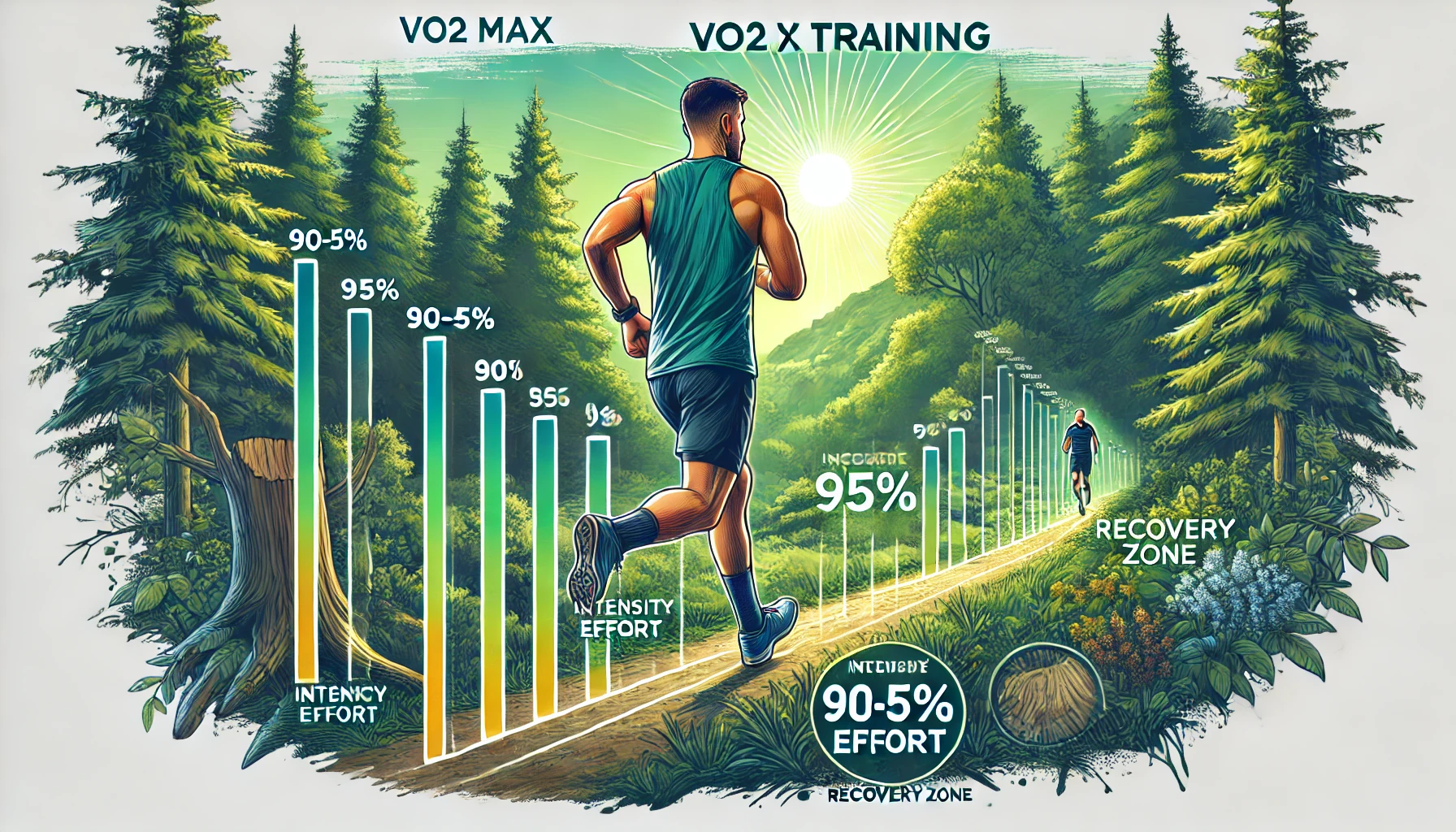No products in the cart.
Understanding VO₂ Max: A Key Fitness Metric for Athletes, High Performers, and Holistic Health
VO₂ max, a critical indicator of aerobic fitness, measures how well your body uses oxygen during intense exercise.
VO₂ max is the single best independent predictor of future life expectancy in both healthy and cardiorespiratory-diseased individuals. (1)
For competitive athletes, middle-aged adults, and those focused on holistic performance, VO₂ max offers significant insights into endurance, cardiovascular health, and physical resilience.
This article explores why VO₂ max is essential for each of these groups, the physical and psychological benefits, and a sample workout using the Norwegian Protocol, which is one of the best ways to help improve VO₂ max.
What is VO₂ Max?
VO₂ max—short for maximal oxygen uptake—is the maximum rate at which your body can use oxygen during strenuous exercise. Measured in millilitres of oxygen per kilogram of body weight per minute (ml/kg/min), VO₂ max is often considered a “gold standard” for cardiorespiratory fitness. The higher your VO₂ max, the better your endurance and the more effectively your body can sustain high-intensity activity.
Factors like genetics, age, gender, and training level influence VO₂ max, but it can be improved through targeted training. This leads to more efficient oxygen delivery to muscles and better overall performance and health.
Physical and Psychological Benefits of Improving VO₂ Max
Enhanced Physical Stamina:
VO₂ max training builds endurance, allowing for more intense workouts and overall energy levels.
Better Weight Management:
Increased oxygen efficiency raises metabolism, aiding weight control and lean muscle growth. (2)
Improved Mood and Reduced Stress:
The dopamine, endorphins, serotonin, and other happy hormones released through exercise boost mood, improve productivity, and unload stress.
Cognitive Clarity and Focus:
A higher VO₂ max enhances brain function, memory, and concentration, promoting mental sharpness and improved decision-making. (3)
Lower Risk of Chronic Diseases:
Higher VO₂ max levels reduce the likelihood of developing conditions like heart disease, diabetes, and hypertension. (4)
Why VO₂ Max Matters for Athletes, for Holistic, Functional Performance, and for Aging Well
1. For Competitive Athletes
Why it’s a Key Metric:
For athletes, VO₂ max is a top metric because it correlates strongly with endurance and high-level athletic performance. A high VO₂ max allows an athlete to sustain intense effort for longer, which is crucial for success in almost all competitive sports. It also plays a role in recovery and overall conditioning, enabling athletes to train more frequently and at higher intensities.
Benefits for Athletes:
Enhanced Stamina and Performance:
A higher VO₂ max means an athlete can sustain high performance longer without fatigue.
Improved Recovery:
Enhanced oxygen efficiency helps muscles recover faster, which is critical for high-level training and competition schedules.
Greater Training Capacity:
The ability to train at higher intensities helps athletes build more speed, power, and endurance.
2. For Aging Well
Why it’s a Key Metric:
VO₂ max naturally declines with age, often dropping by about 10% per decade after the age of 30. This decline can impact mobility, cardiovascular health, and the ability to engage in daily activities. Maintaining or improving VO₂ max helps counteract age-related decreases in cardiovascular efficiency, allowing middle-aged and older adults to stay active, healthy, and independent.
Benefits for Middle-Aged and Older Adults:
Heart Health and Longevity:
Improved VO₂ max is linked to reduced cardiovascular disease risk and longer lifespan.
Functional Mobility and Strength:
With a higher VO₂ max, daily tasks like climbing stairs or carrying groceries become easier.
Injury Prevention:
Better aerobic conditioning supports muscle and joint health, helping to prevent injuries from falls or strain.
3. For Holistic and Functional Performance
Why it’s a Key Metric:
VO₂ max is a strong predictor of overall functional health. Higher VO₂ max levels indicate not just aerobic fitness but also resilience to stress, both physically and mentally. For those aiming for a holistic approach to health, VO₂ max serves as an important measure of how well the body and mind can handle daily demands, whether it’s work, family, or fitness.
Benefits for Holistic and Functional Health & Performance:
Functional Endurance:
Improved VO₂ max translates to better performance in everyday physical activities, from lifting groceries to walking up stairs.
Enhanced Cognitive Function:
Efficient oxygen use supports brain health, improving focus, mood, and mental clarity.
Energy and Vitality:
A higher VO₂ max means more stamina and a decreased feeling of fatigue throughout the day.
What Works (and What Doesn’t) for Improving VO₂ Max
Some training methods have minimal impact on VO₂ max because they lack the intensity to challenge the cardiovascular system. For example, light activities like walking, gentle yoga, or low-intensity strength training don’t raise the heart rate high enough to significantly increase oxygen uptake. While these are great for overall health, they don’t push the limits of the cardiovascular system, which is essential for VO₂ max improvement. Effective VO₂ max training requires high-intensity intervals or a long-term progressive overload to boost oxygen consumption and endurance.
Sample VO₂ Max Workout: The Norwegian Protocol
Before you attempt this workout, please keep in mind the following:
Starting VO₂ max training without enough aerobic fitness, strength, or proper movement skills can increase the chance of injuries and halt progress. Without a solid aerobic base, intense intervals can quickly cause fatigue, poor form, and lower workout quality, making it harder to improve. Weak muscles and joints are more likely to get strained, sprained, or develop issues like tendinitis. Plus, without good movement patterns, people may use awkward techniques that lead to overuse injuries. Building up aerobic fitness, strength, and safe movement skills first helps avoid these risks and sets up for lasting success with VO₂ max training.
Improving VO₂ max often involves interval training that alternates between high and low intensities, which helps the heart and lungs work more efficiently. One of the most effective methods is the Norwegian Protocol, a scientifically-backed workout that can elevate VO₂ max for athletes and non-athletes alike.
Norwegian Protocol Workout
1. Warm-up
10-15 minutes of light aerobic exercise, such as jogging or shadow boxing, to prepare the body for high-intensity work.
2. Work Sets
Perform 4 x 4-minute high-intensity intervals at 85-90% of your maximum heart rate. This should feel challenging but manageable. A simple way to work that out is your 220 minus your age = max heart rate. Follow each 4-minute interval with a 3-minute recovery period of low-intensity exercise, allowing heart rate to decrease.
3. Cool-down
10-15 minutes of low-intensity activity, like walking or light jogging, to bring the heart rate back to a resting state and reduce muscle stiffness.
4. Frequency
Performing a workout at this intensity shouldn’t be done more frequently than once every ten days or so, with rest or lower-intensity days in between sessions, to promote recovery and to strengthen other systems (e.g., muscles, aerobic fitness).
How to Implement the Norwegian Protocol Safely
The Norwegian Protocol is both effective and intense, so it’s important to approach it with a focus on safety and long-term goals:
- Consult a healthcare provider if you have any health conditions before starting high-intensity exercise.
- Work with a professional: Vo2max workouts are very challenging. You need to build up to being able to do it properly. Working with a professional coach is the safest, fastest route.
- Stay aware of your heart rate: Aim for around 85-90% of your maximum heart rate but don’t push too far beyond; heart rate monitors or smartwatches can help.
- Prioritize recovery: Use the rest periods and post-workout cooldown to slow your heart rate, reduce muscle soreness and minimize injury risk.
- Listen to your body: If any drill causes discomfort or pain, adjust the intensity or try a less demanding option.
Final Thoughts
VO₂ max is more than just a measurement; it’s a key marker of health and performance that








Leave a Reply